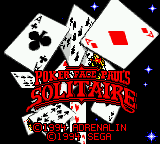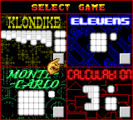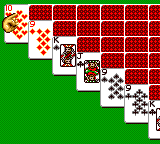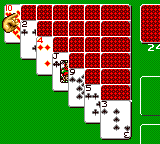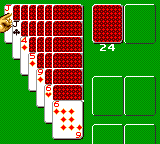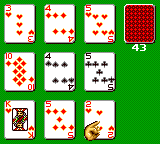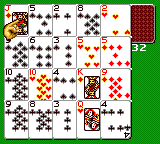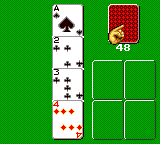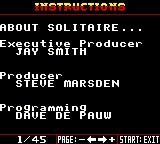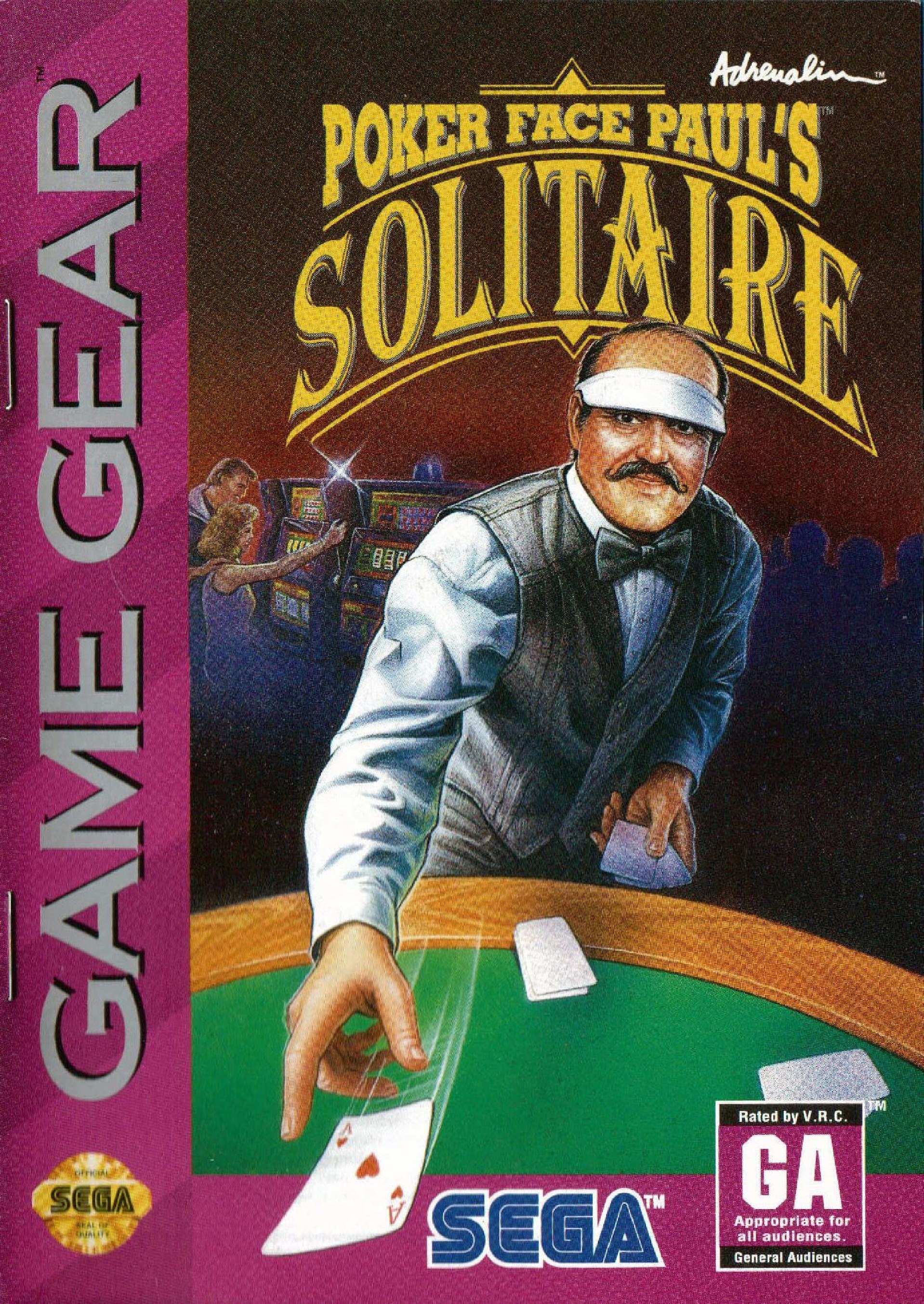Poker Face Paul's Solitaire
From Sega Retro
| Poker Face Paul's Solitaire | ||||||||||
|---|---|---|---|---|---|---|---|---|---|---|
| System(s): Sega Game Gear | ||||||||||
| Publisher: Adrenalin Entertainment | ||||||||||
| Developer: Spidersoft | ||||||||||
| Genre: Table | ||||||||||
| Number of players: 1 | ||||||||||
|
Poker Face Paul's Solitaire is a solitaire game for the Sega Game Gear. It was only released in North America.
Contents
Gameplay
The game is a collection of four solitaire games. It uses a cursor interface where the D-Pad moves the hand-shaped cursor between cards and ![]() or
or ![]() picks up or places down a card.
picks up or places down a card.
In all games, there is a setting to enable hints. The game keeps statistics for games that have been played (though this information is lost when the console is powered off). Games are not counted in the statistics when hints are used.
During a game, the player can bring up a menu by pressing START that contains an option to read in-game instructions or quit and return back to the main menu to change options or start a different game.
Games
| Klondike | |
|---|---|
| The goal is to move the entire deck onto the four bases, which are initially empty, in ascending order and with alternating red and black colors (in any suit). Only an Ace (the lowest card) can be moved onto an empty base. At the start of the game, there are seven rows of cards dealt onto the board face down. Each successive row is one card shorter than the last, with all of the cards face down except one at the end. The player can organize the cards using the seven rows, in descending order. Only a King (the highest card) can be moved onto a row once it has become empty. At the start of the game, there are 28 cards arranged in the rows, with the remaining 24 cards available in the deck. The player can draw additional cards from the deck one at a time; the deck can be cycled an unlimited number of times.
The game is won when all cards have been moved to the bases in the correct order or lost when there are no more moves that can be made. The player can choose a time limit between 6 and 10 minutes or no time limit. When hints are enabled, the game helps move cards to the correct bases. There are three different views available: Normal, Small 1, and Small 2. Normal and Small 1 show more of the cards but require panning to view the entire board. Small 2 is the default and the most compact view, only requiring panning when the rows grow. | |
| Elevens | |
| The goal is to clear the board by removing the cards in pairs that add up to 11 (with Aces worth 1). The player can also match and remove any three cards of the same value that line up in a row, column, or diagonal or any three face cards. At the start of the game, the player deals out nine cards in three rows of three cards. Pairs are removed by selecting each card one at a time; when a card is removed, another one is automatically drawn from the deck and put in its place until no additional cards remain.
The game is won when all cards have been removed or lost when there are no more moves that can be made. The player can choose a time limit between 2 and 5 minutes or no time limit and a number of decks between 1 and 4. When hints are enabled, the game briefly flashes legal card combinations when they appear. | |
| Monte Carlo | |
| The goal is to clear the board by removing the cards in pairs with the same face value (regardless of suit). The cards must be next to each other horizontally, vertically, or diagonally. At the start of the game, twenty cards are dealt out in four rows of five cards. When a pair of cards is removed, the cards below it are shifted up or from the right to fill the missing space (with additional cards dealt out to ensure that there are always twenty cards on the board, unless there are no more cards remaining).
The game is won when all cards have been removed or lost when there are no more moves that can be made. The player can choose a time limit between 2 and 5 minutes or no time limit and a number of decks between 1 and 4. When hints are enabled, the game briefly flashes legal card combinations when they appear. | |
| Calculation | |
The goal is to build four rows by laying the cards down in four different sequences:
At the start of the game, there are four cards placed in four rows. The player pulls one card at a time from the deck and places it on one of the rows if possible. If there is no valid place for the card in one of the rows, the player must place the card in one of the four discard piles and draw another card from the deck. Multiple cards can be placed in any discard pile in any order, but only the top card can be removed and placed in a row. The player is only allowed a limited number of passes through the deck. The game is won when all cards have been placed in the four rows or lost when there are no more moves that can be made. The player can choose a time limit between 4 and 7 minutes or no time limit and a number of passes between 1 and 4. When hints are enabled, the game shows the next card needed in each row. |
Production credits
- Executive Producer: Jay Smith
- Producer: Steve Marsden
- Programming: Dave De Pauw
- Graphics: Robert Lever
- Music and Effects: Mark Cooksey
- Help System and Text: Matt Taylor
- Producer: Jay Smith
- Product Manager: Chrissie Huneke
- Software Developer: Spidersoft
- Test Lead: John Pedigo
- Manual: Carol Ann Hanshaw
Magazine articles
- Main article: Poker Face Paul's Solitaire/Magazine articles.
Promotional material
also published in:
- GamePro (US) #60: "July 1994" (1994-xx-xx)[3]
- Sega Visions (US) #21: "October/November 1994" (1994-xx-xx)[4]
Physical scans
| Sega Retro Average | ||||||||||||||
|---|---|---|---|---|---|---|---|---|---|---|---|---|---|---|
|
| 63 | |
|---|---|
| Based on 2 reviews | |
Technical information
ROM dump status
| System | Hash | Size | Build Date | Source | Comments | |||||||||
|---|---|---|---|---|---|---|---|---|---|---|---|---|---|---|
| ? |
|
128kB | Cartridge (US) |
References
- ↑ File:Poker Faced Paul's Solitaire GG credits.pdf
- ↑ File:PFPS gg us manual.pdf, page 14
- ↑ GamePro, "July 1994" (US; 1994-xx-xx), page 129
- ↑ Sega Visions, "October/November 1994" (US; 1994-xx-xx), page 81
- ↑ GamePro, "July 1994" (US; 1994-xx-xx), page 136
- ↑ VideoGames, "June 1994" (US; 1994-0x-xx), page 80
| Poker Face Paul's Solitaire | |
|---|---|
|
Main page | Hidden content | Magazine articles | Reception | |
| Poker Face Paul games for Sega systems | |
|---|---|
| Poker Face Paul's Blackjack (1994) | Poker Face Paul's Poker (1994) | Poker Face Paul's Gin (1994) | Poker Face Paul's Solitaire (1994) | |
| Poker Face Paul's Cribbage (unreleased) | |
